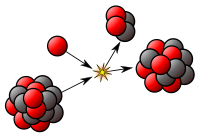
Spontaneous fission

Spontaneous fission (SF) is a form of radioactive decay that is found only in very heavy chemical elements. The nuclear binding energy of the elements reaches its maximum at an atomic mass number of about 56; spontaneous breakdown into smaller nuclei and a few isolated nuclear particles becomes possible at greater atomic mass numbers. Spontaneous fission (SF) is a form of radioactive decay that is found only in very heavy chemical elements. The nuclear binding energy of the elements reaches its maximum at an atomic mass number of about 56; spontaneous breakdown into smaller nuclei and a few isolated nuclear particles becomes possible at greater atomic mass numbers. The first nuclear fission process discovered was fission induced by neutrons. Because cosmic rays produce some neutrons, it was difficult to distinguish between induced and spontaneous events. Cosmic rays can be reliably shielded by a thick layer of rock or water. Spontaneous fission was identified in 1940 by Soviet physicists Georgy Flyorov and Konstantin Petrzhak by their observations of uranium in the Moscow Metro Dinamo station, 60 metres (200 ft) underground. Cluster decay was shown to be a superasymmetric spontaneous fission process. Spontaneous fission is feasible over practical observation times only for atomic masses of 232 amu or more. These are elements at least as heavy as thorium-232 – which has a half-life somewhat longer than the age of the universe. 232Th, 235U, and 238U are primordial nuclides and have left evidence of undergoing spontaneous fission in their minerals. The known elements most susceptible to spontaneous fission are the synthetic high-atomic-number actinides and transactinides with atomic numbers from 100 onwards. For naturally occurring thorium-232, uranium-235, and uranium-238, spontaneous fission does occur rarely, but in the vast majority of the radioactive decay of these atoms, alpha decay or beta decay occurs instead. Hence, the spontaneous fission of these isotopes is usually negligible, except in using the exact branching ratios when finding the radioactivity of a sample of these elements. The liquid drop model predicts approximately that spontaneous fission can occur in a time short enough to be observed by present methods when where Z is the atomic number and A is the mass number (e.g., Z2/A = 36 for uranium-235). However, all known nuclides which undergo spontaneous fission as their main decay mode do not reach this value of 47, as the liquid drop model is not very accurate for the heaviest known nuclei due to strong shell effects. In practice, 239Pu will invariably contain a certain amount of 240Pu due to the tendency of 239Pu to absorb an additional neutron during production. 240Pu's high rate of spontaneous fission events makes it an undesirable contaminant. Weapons-grade plutonium contains no more than 7.0% 240Pu.
